
(Shoko LEE ,1978)

(Shoko LEE ,1978)
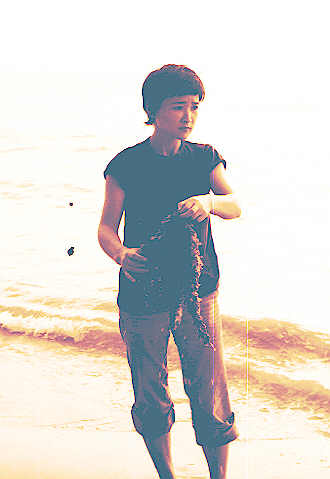
(Shoko LEE ,1978)
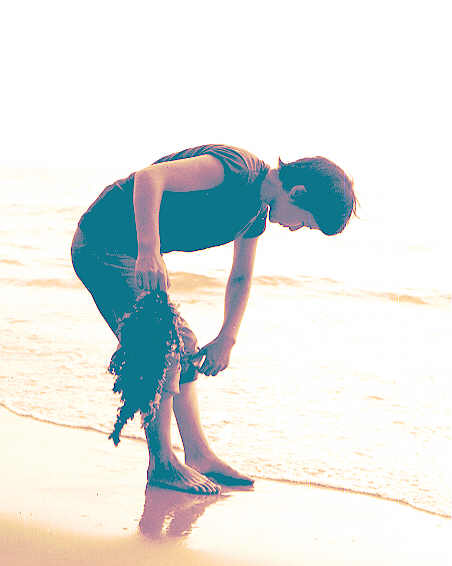
(Shoko LEE ,1978)
Shoko Lee Embodies the Confidence of the Chinese Culture by LEE Kian Seng
( Note: “Shoko LEE Embodies the Confidence of the Chinese Culture” written by LEE Kian Seng is actually the combination of 2 essays ,excepts the footnotes, published in Nanyang Siang Pau Malaysia on 20 June 1996 and Sin Chew Daily Malaysia on 4 November 2004 respectively.)
"We must not cease from exploration and the end of all our exploring will be to arrive where we began and to know the place for the first time." - T. S. Elliot, American poet.
1972 marked the start of an epic journey for Shoko Lee. Back to square one, she had to start all over from scratch.
That year, Shoko made up her mind to bid farewell to her motherland Japan. For her, it was the end of an epoch and the beginning of a new one. She was assuming a fresh identity. A new belief system was replacing the emotional baggage of the past. Without looking back, she boldly severed all ties to her native country. In its place, she regained the very soul of her humanity—dignity and self-respect. This psychological breakthrough led her to experience for the first time what it means to be truly free as an individual. She began to understand that freedom of choice is by far the most basic right one is entitled to in life.
A paradigm shift (Note 1) can accomplish much more than the betterment of mental powers. The quality of the soul and spirit is elevated as well. With a freshly regenerated state of mind, Shoko spared no effort in settling into her new life in Malaysia. In time, the formerly strange and unfamiliar sights and sounds in addition to the diversity of culture and customs became a part of her life. In an environment conducive to self-made creativity, she managed to take the almost suffocating stereotypes of her past and translate them into positives. Her life embodied the vigor of life with all its untapped potentials. Her emerging self-confidence nurtured her aspiration to be an artist. So it was that Shoko Lee gradually threw herself into the world of art. She turned out to be an exotic bloom on the Malaysian art scene. As Goethe once observed the seed "scattered in the soil, never doubting it would not sprout; it does not worry it cannot come out of the soil, it does not complain of the rock that is on top of it. It bestows unfailing determination to rise out of the ground, grow leaves, blossom, then bear fruit". (Note 2)
|
|
The Sunny Boy series, 1972-1981 |
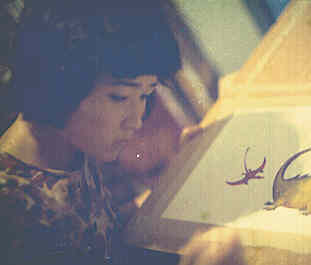
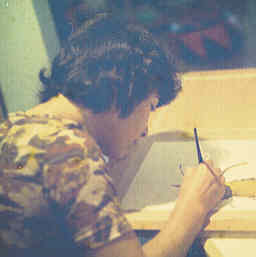
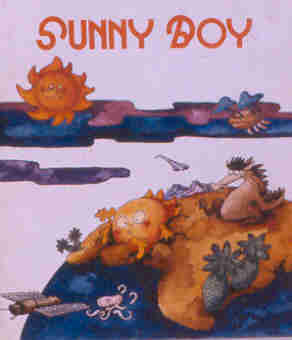
Shoko LEE,1972)
Technology has yet to create a robot that dreams. I wonder if animals have dreams too. At least on humanitarian grounds, we cannot stop people from dreaming. Even daydreaming is a basic human right.
Woodrow Wilson once said, “We grow great by dreams. All big men are dreamers.”
So Shoko Lee began dreaming in 1972.
The simple rural kampong, the sun, the moon and the stars in the Malaysian night sky, and the primitive, unpolluted natural landscape never failed to fascinate her and captured her imagination. Just as her dreams were taking shape, her interest in exploring the mysteries of the universe grew. This combination of factors drove Shoko to create the Sunny Boy series. Meanwhile, she was captivated by cosmological reports in the journal Scientific American. Through the leading character of the Sunny Boy series, she has given free rein to all of mankind’s unique natural endowments, self-awareness, imagination, conscience and free will.
Through the Sunny Boy series, we witness the entire process of Shoko’s initial seeding, tilling and pruning in her art career. Seeing life through the eyes of a child, she translated her hopes, dreams and circumstances of life figuratively on to the canvas. The make-up of the protagonist turned out to be her innermost thoughts and emotions personified. More than a fitting symbol of the start of an epic struggle in her art career, Sunny Boy was a demonstration of her self-transcendent mindset.
Shoko Lee gave up eight years of youthful vigor through the 1970’s to produce the Sunny Boy series. The first volume of the series made its debut in 1980. It was an instant smash hit on the local art scene. It continued to garner international acclaim when it made the list of selected national publications to represent Malaysia at the Frankfurt World Book Fair in 1981. As far as her commitments and dreams were concerned, this achievement represented an initial success with the promise of more to come. Through her works, she shares her fantasy world of space travel with the audience. (Note 3)

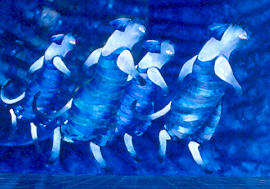
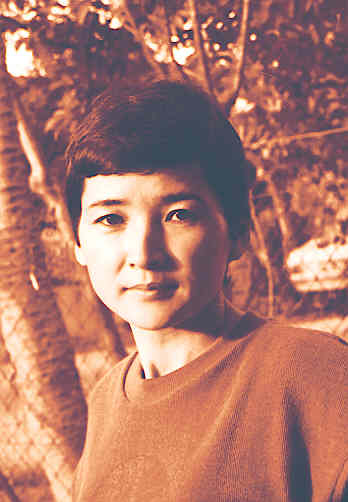 Shoko Lee
1983
Shoko Lee
1983
“I know of no more encouraging fact than the unquestionable ability of man to elevate his life by conscious endeavor.” -- Henry David Thoreau, 19th century American author and philosopher.
If man had no ability to elevate his life by conscious endeavor, he would be no different than a robot or an animal. (Note 4)
In the early 1980’s, Shoko Lee had moved on to the next stage of her life. Having just become a mother, she was going through some psychological and physiological changes. These surges drove her to initiate another series of work—the My Diary series. In her own words: “Before the birth of my child, my mind was full of fantasies and imaginations. I would conjure up images of the sun and moon floating effortlessly around in space as if cut loose from the pull of gravity. A red chair would fly through the air. Cups and lamps would dance in mid air. Up next would come the red capsicums and a whole range of other things.”
The pictures evoked a sense of free rein akin to space walk and reflected the mysteries of boundless space that she was experiencing. They also revealed the excited anticipation of bringing up her little bundle of joy. Her experiences of daily living mingled with the beautiful dreams for and visions of the future found expression in the form of fruits, underwater creatures, cradles and toys. She did a marvelous job translating her innermost feelings vividly on to the canvas through the medium of color. During this time, her unique flair and style as an artist gradually took shape.
Human passions and contemplative thoughts combine to form the backbone of the character of an artwork. The noble conception of art originates from one of the branches of ethics, while traditional aesthetics usually stems from philosophy. The principles of aesthetics probably evolved from within the philosophical system to interpret the perceptions and conceptions of psychology towards “beauty.” But Shoko’s My Diary creations emanated from a primitive intuition and joy—an anticipation for the arrival of a new life. Her works stirred the interactive depths of the human soul, leaving the viewer with an unspeakable wonder and amazement.
“My works were the equivalent of my days,” said Shoko, revealing the longing in her soul. A new energy was being unleashed from her inner soul into the open.
My Diary (part 2 ) 1983-1985 - The Joy of Living
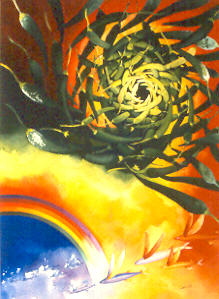
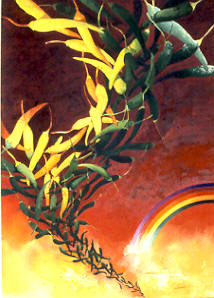
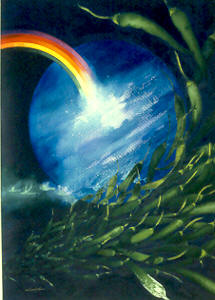
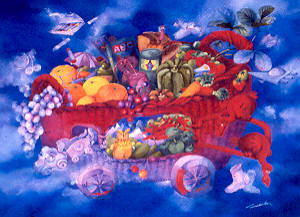
Chillies, toys, fish, cats, dogs, poultry and other domestic animals are all mundane things or day-to-day experiences we humans encounter in our living environment. But through the artist’s senses and creative, refined strokes, these things become wonders to the eyes. Shoko’s works of this period led the way in breaking through the confines of real objects and their field of vision.
Having just enrolled in kindergarten, three year old Hui Ling brought home new lessons she had learned at school every day. She would talk to the cats and dogs at home. Her love for animals and plants, coupled with her joyful innocence and liveliness, naturally filled every corner of Shoko’s life and works. The joy of living had generated in her a tremendous force of creative energy. Lee Hui Ling was the little explorer who imperceptibly introduced into Shoko’s world of art such ABC’s as insects, dragonflies, flowers, fowls, fish and toys, which enriched her fountain of creativity much like a battery having been recharged.
Chillies were Shoko’s all time favorites during her pregnancy. Her daughter’s first hilarious attempt at tasting a chilli strengthened her impression of those hot and spicy little peppers. Baskets of chillies in the wet market would form a major theme of her artworks in later years.
Shoko had indeed transformed the bits and pieces of her life into immortal masterpieces. (Note 5)
My Diary (Part 3 ) 1985-1988 --- Auspicious animals
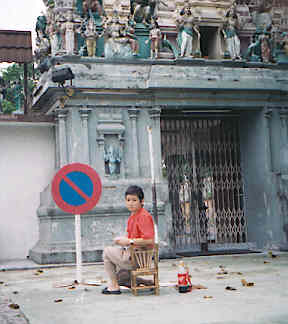
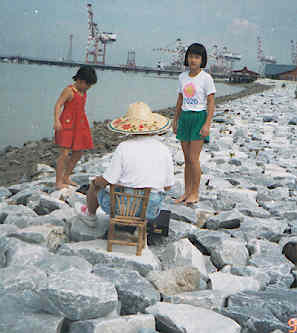
(Shoko Lee. December 24,1993)
( Shoko LEE, Lee Hui Ling and Lee Hui Lian .
November 9,1993.)

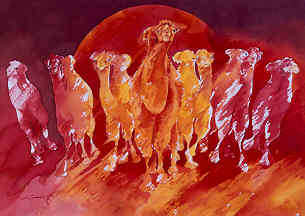
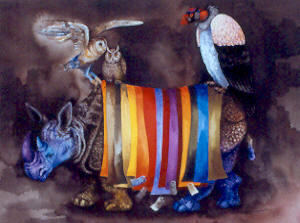
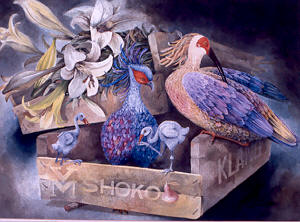
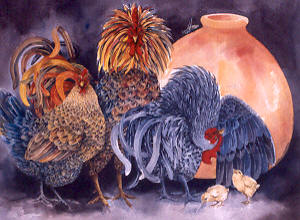
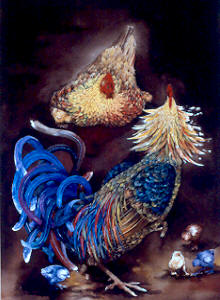
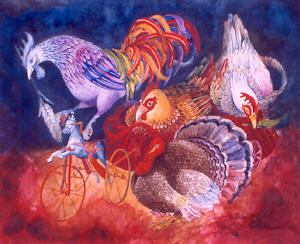
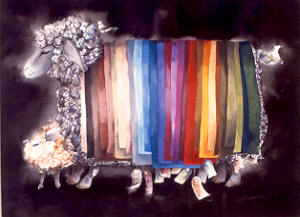
“Beauty unaccompanied by virtue is like a flower without
scent.” (French Proverb)
It was the year 1985. Hui Ling was enrolled in kindergarten. Her younger
sister Hui Lian was one year old.
At a time when the girls were developing their creative, mental and cognitive abilities, Shoko found herself in her element, as if she was roaming the children’s playground through the eyes of a little angel. Her love for animals and her growing interest in nature led her and the girls into the amazing world of animals. At this time, she started to work on themes around day-to-day living and herds of peaceful creatures. Based on her life experiences and with a keen artistic sense, she refined the images of animals on canvas. These had been the avenues through which she expressed her inner feelings and concern toward the ecosystem as well as her admiration for the beauty of nature.
However, Shoko was anything but a traditional animal artist.
With firm but gentle strokes, she adorned the simple farm animals such as the stately turkeys with bright and radiant colors. The Owl Family was bubbling over with endless fun and humor. Herds of animals were clothed in colorful rainbow, refined and unrestrained, showing forth qualities of elegance. The zebra’s stripes momentarily stirred. The camel danced to the melody. The fleets of dragonflies reminded one of a once happy childhood.
Her excitement having been aroused by fertile imagination, Shoko perfected the medium of watercolor and took it to a distinctive level of artistic professionalism.
My Diary (Part 4), 1989-1993 - The Amazing Bamboo: A Tale of hollow stems and tough joints
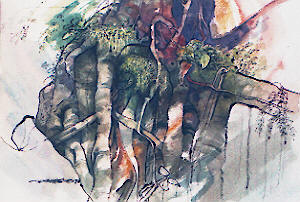
While part four of her works, My Diary 1989-1993, was in the process of production, several activities that had become part of her daily routine provided a framework for the thoughts that went into this series.
Hui Ling had just entered elementary school when the little girl brought the novelty of computer games into her mother’s world. In the aftermath, Shoko churned out a large number of computer game productions. At this time, the younger Hui Lian had enrolled in kindergarten. Once again Shoko could not help but renew her interest in painting livestock and herds of animals.
In particular, the composition of groups of flying lions in an imposing yet tender manner gave the audience an intuitive sense of the vitality and freedom of life.
Whenever the family went on an outing to the countryside, she would take along her bamboo brush and ink to paint from life the patterns of the natural world.
During this time, Shoko’s passion for the study of ancient Chinese civilization could only match the obsession she had had with the journal Scientific American some twenty years before. As a result, she produced a series based on the twelve animal signs of the Chinese zodiac depicting the likes of crouching dragons and dancing stallions.
My Diary (Part 5 ) —Soul, 1989-2004 - Embodying the Confidence of the Chinese Culture
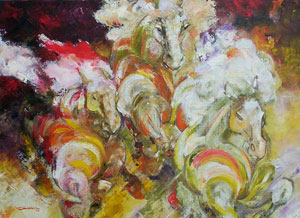
One of the social functions of the artists is to express the true dimension of their own soul in day-to-day living. In so doing, they are enriching the souls of all mankind.
Just as everyone was anticipating the sequel to the latest of Shoko’s My Diary, Hui Ling and Hui Lian had both grown up. Each of them was set to pursue her own course. Hui Ling was bound for New York for tertiary education, and Hui Lian was leaving for Singapore for secondary . With an empty nest, there was naturally more room for Shoko to develop herself mentally and spiritually, like a wild runaway horse galloping in the open country. She spread the image of the dancing stallion on the canvas, capturing it and then releasing it. It was an enigmatic interplay between strength and rhythm.
The bulk of the Dancing Horses series took almost three years to complete.
Having fused into the spirit and confidence of the Chinese culture, Shoko went on to paint the stately and cocky dragon. The shape assumed by the mythical character in the Dragons series expresses the unique aesthetic and creativity of the Chinese people. The dragon was an imaginary creature conceived by the ancient Chinese as a symbol of idealism. In the eyes of the global Chinese community, this auspicious animal continues to be an emotional bond and emblem underpinning their shared ethnic identity today. The bulk of the Dragons series opened at the National Art Gallery Malaysia in 2000.
The Dancing Dragons and Dancing Horses series speak volumes about her passion for the freedom to create. With firm yet gentle strokes and her uninhibited and profound impetus from diverse perspectives, Shoko mixed a bright profusion of colors to seize the defining moment of inspiration and let her soul run off with the Galloping Horses under her brush. Her canvas was ever teeming with life and vigor.
Shoko’s works over the past 36 years speak of the gradual enrichment of her central thought and philosophy of life in the world of art on Malaysian soil. The diversity of culture has nourished her soul even as the morning dew moistens the ground. She has been living out the true essence of life in the new world she created. Her inner qualities have been elevated. She has developed an extraordinary bird’s-eye view of the world. She possesses introspective vision and space. Her life honestly embodies the self-confidence of the Chinese culture, while suggesting a potentially explosive energy for greater achievements on the art scene.
What’s On My Mind
The real world is comprised of countless chains of causes and effects.
Ecologists in recent years have come to a new understanding of the relationship between man and nature. The two are inextricably linked to one another. All creative acts are but the products of the movement of our natural environment. Such complex behavior is constantly on the move. Structure is affecting changes in the way we think and perceive. I attach great importance to the originality of an artist’s work, as well as the coherence of the work and the hidden factors affecting the various stages of production.
The international community of the 21st century is
going through an unprecedented time of disputes and challenges over moral
values. It certainly looks as if the current trends in contemporary world art
have come to a crucial point where artists are forced to take a hard look at
traditions and seek out new directions for the future. In this serendipitous
moment in history, I can foresee the rich resources and magnanimous qualities of
the Chinese civilization, culture and arts, coupled with the huge population of
China going into the world, playing a crucial role in setting a new trend of
thought on the Asian art scene. This is not a case of Chinese chauvinism but
rather the inevitable in the course of history.
Note 1:Thomas
Kuhn, a US historian first used the term ‘paradigm’, in 1962 in his article “The
Structure of Scientific Revolution.” He argued that all knowledge is dependent
on the ‘paradigm’ (or theoretical framework) that dominates a person’s mind.
Shoko Lee has fully brought her proactive principle into play in her own life and created a new world of her own. In the 31 years following 1978, she has never again set foot on Japan. Years of painstaking effort have finally freed her from the entire domain possibly covered by the theories of genetic, psychic and environmental determination, and allowed her to rise above them. However, just as she was determined to propel herself forward to new heights in her art career, things started to go wrong. It looked as though she could not evade the onslaught of a sinister fate. She was caught by her own blind spots and naivety. She was stranded on the shallow beach with her cry strangled.
(Note 2): The troubles that we humans bring upon one another are often the stuff that tries our faith and strength of mind. In 1972, Shoko Lee began the long process of application for the status of Malaysian citizenship. It was unfortunately denied. She reapplied in 1977. In the years since 1978, she has never again visited Japan. In fact, she has taken a vow of disaffection to Japan, and voluntarily renounced her Japanese citizenship. In short, she has severed all ties to her motherland. It was not until May 14, 1998, that she was finally granted permanent resident status. On June 14, 2000, her name was officially changed under oath to Shoko Lee in accordance with the law of Malaysia (Bil. (2) dlm JPN.KP: 163/683/PD IP0359(6)2000 Jabatan Pendaftaran Negara Malaysia). Shoko received her Malaysian citizenship status and her Malaysian identity card (Mykad) on July 23, 2001, along with all the rights and privileges a citizen is entitled to. A Malaysian international passport was issued to her on August 16 the same year.
In a letter dated 3rd June 1996, LEE Kian Seng wrote to the Embassy of Japan in Kuala Lumpur Malaysia to file a complaint against its Japanese officer for her unlawful conduct which had infringed on human rights. No reply yet. In another letter dated 14 July 2003 addressed to the Ministry of Foreign Affairs in Malaysia, Lee Kian Seng joined Shoko LEE again filed a complaint against the officer in the Embassy of Japan in Kuala Lumpur for infringement of human rights, with report of Shoko Lee’s dated 8th June 1996 attached. No reply yet.
In accordance with the immigration law of Malaysia, Shoko Lee had surrendered her invalid Japanese passport (No. M20113939) on August 1, 2001, to the Immigration Department of Malaysia, who would in turn hand it over to the Japanese Embassy in Kuala Lumpur. Everything had been done in accordance with the law of Malaysia.
(Note 3): Nevertheless, any unique work of art would be doomed for failure in a time when high-handed tyranny was the order of the day. The kind of encroaching and engulfing manipulation was beyond her capacity to grasp. This series of publication did not even get to see the light of day. What is more, she waited for ten long years before her copyright was given back to her. Ten years of hiatus on top of eight years of hard work went down the drain in an instant. That represents 18 years of youthful life frittered away without a trace. Some say it was perhaps a scheme of systematic marginalization of a certain group. Ironically, this had all happened in the heyday of Tun Mahathir’s “Look East” policy (1981-2003).
"....Mahathir, enough is enough. The people have been under your delusion for decades. We always say that the British were good at" divide and rule" but I think you, Sir, are the real master. The 22 years ( The Look East policy 1981-2003)under Mahathir have resulted in a partitioned and untrusting Malaysian community. All the while, Mahathir was exploiting this antagonism, and reaping the benefits of autocracy..." ( excerpted for Sin Chew Daily Malaysia / 22 July 2009 <Dear Mahathir, Enough is Enough>written by Tay Tian Yan ).
(Note 4): Aired in an interview with TV3 “Suasana” segment on August 19, 1997. Reported in the China Press on May 10, 1998, in an article titled “Shoko Lee: Education through animal painting. Never too old for a mother to pick up new tricks.” Reported in a weekly interview of Sin Chew Daily on its October 13, 1996 edition under the column Life Partners in the World of Art—“Our policy as a family stems from an awareness of the Malaysian culture. We do not embrace two cultures at the same time. This has ever been the motto of our family.”
( Note 5) In the exhibition catalogue ‘MY DIARY 1983 – 1985’), director of the National Art Gallery Malaysia Syed Ahmad Jamal wrote that ", Everybody goes through life with an unwritten diary; full of moments of cherished memory. Shoko immortalised fragments of life for posterity, for viewers to enjoy and thus enriching his/her life. Shoko, the dedicated artist, religiously notes observations in her diary. This is her gift for us to savour. To Shoko thank you for reminding us of the wonder of life."
by LEE Kian Seng
(Special note: LEE Kian Seng was born in China. The bloody racist may not refer to him as a Chinese artist, but his works have often been altered, dismembered, stolen and infringed on by certain quarters maintaining a grip on the official publications in Malaysia. Shoko Lee is a Malaysian citizen born in Japan. For 33 years she has never set foot on Japanese soil. Some people like to twist the facts and make her out to be a Japanese artist. If one were to place her works My Diary Series alongside the works of Malaysian artists, the answer would be plain. This was because not a small number of artists had copied the trend of thoughts found in her works. It was this little pack of pawns in the art and culture circles ( inclusive part Chinese) who engineered the whole fiasco. After all, twisting the facts has ever been characteristic of a few bad-blooded individuals in the art and culture circles of Malaysia. )
--------------------------------------------

@@@@@@@@@@@@@@@@@@@
|
|
Appendix 1 (excerpted from The Souvenir Programme of The Exhibition ‘MYDIARY1985-1988) |
Shoko LEE
Although born in Japan, Shoko is in reality a Malaysian artist. She has lived twenty-four years of her life in Malaysian, more than her life in Japan, a country she last visited nineteen years ago. Married to LEE Kian Seng, a renown Malaysian artist, Shoko has two children through whom she draws a lot of inspiration.
My first introduction to Lee Kian Seng was by the late Frank Sullivan, as the young artist, clad in batik from top to toes ( his canvas shoes were in batik) was preparing his exhibition at the Samat Art Gallery in 1968. I have been in touch with the artist and his wife Shoko, since the couple set their home in Malaysia in 1972.
Shoko is overwhelmed by the wonder of the simple things in a new life in Malaysia. Like a child she is still in awe of the natural world, especially that of the fauna – the animals, the birds, children, and life that evolves around them.
The artist keeps a diary of the world that she observes. Unlike a writer who writes down his experience and observation, Shoko draws and paints which she does with form and content.
In her Diary 1985-1988, Shoko depicts her observation with the eye of the child wondering in her little world in which even the simple things have a sense of grandeur. The artist bestows playfulness as well as the dignity of grandeur.
The artist proposes ironic humour as the regal tiger is given new stripes of multi coloured silken drapes; so is the armour-plated rhinoceros. She portrays the lowly cockerel, hen and turkey with affection, reminding us of the natural flamboyance which they possess and which we let pass by in our daily pursuit of material gains.
Shoko shows love among the so-called wild animals, portrayed by a tigress cuddling her young cub. She reminds us of the joyous days of childhood as in the squadrons of dragonfly hovering over some goats.
The medium of watercolour on paper is expertly handled to result in some brilliant, transparent treatment that seems to glow as if it lit from within. One of the roles that the artist plays is in making visible the inner dimensions of life. That Shoko does with harmony, love and her special vision of the world, which we once knew.
-----------by Datuk Syed Ahmad Jamal, K.M.N. Seniman Negara, Gombak, Malaysia .January 1996.
|
|
Appendix 2 (Excerpted from The Souvenir Programme of The Exhibition ‘MY DIARY 1983 – 1985’) |
The child, chili, toys, - these are ordinary things, universally experienced by many human beings – yet the ordinary becomes extraordinary through the artist’s perception, sensibility and mediation via the art form. One of the primary roles of the artist is to make us aware of an aspect of reality – in visual art to make his/her awareness visible for all to experience.
Shoko, is not just an (ordinary) artist, but an extraordinary one. Through the artist’s highly intensified perception of objects and environment, the viewer is made aware of his/her childhood days, of moments long forgotten, of simple things, which are there all the time – everyday. We take these things, the simple joys of life, for granted, yet each of them is a miracle which makes life so wonderfully full of wonders. The objects or events are rearranged in juxtapositions of human-made dreams. Some of these dreams are experienced by ordinary mortals, yet through the artist’s imagination and skill – they become real, positing inner reality.
Everybody goes through life with an unwritten diary; full of moments of cherished memory. Shoko immortalised fragments of life for posterity, for viewers to enjoy and thus enriching his/her life.
Shoko, the dedicated artist, religiously notes observations in her diary. This is her gift for us to savour.
To Shoko thank you for reminding us of the wonder of life.----by Syed Ahmad Jamal , Director, National Art Gallery, Malaysia,1985.
|
|
Appendix 3 (Excerpted from The Souvenir Program of The Exhibition "MY DIARY 1981 – 1983") |
Shoko LEE first made an indelible impression of the Malaysian Art scene through her illustrations of ‘Sunny Boy’. These were wondrous ventures into the realm of phantasy, of personal legend, reminding one of ‘The Little Princes’.
With the present series of watercolour paintings, the artist of Sunny Boy has come of age, entering the ‘legitimate art’ circle. Art makes it possible to realise the dreams of our will. The age of rational has produced parallels in irrationality, creating the balance, lest we become too intense with seriousness. In the spirit of ‘Sunny Boy’ it is important that we retain the child’s sense of wonder of the ‘simple’ world – such as the sky, where one’s imagination is free to wonder from the everyday demands and chores to the limitless bounds of the thinkable space. Shoko let her mind wonder and her imagination wander among the boundless universal space. Being an artist she is able to translate her responses into visual forms which are then transmitted to us in a new differentiated reality. We, as observers, are on turn enriched by the dimension of her experience… In her present collection of works aptly titled ‘My Diary’ stretching from 1981 to 1983, all those wondrous ecstatic moments of sheer serendipity, of the playful joy, are set in pictorial space – form and space being the main elements in visual/pictorial art.
The artist is inspired by space, rearranging objects in an irrational configuration in space. The elements of ‘irrationality’ are essential in a highly rationalised order of the condition of society.
In these works, the artist relates the ordinary everyday objects with which she is so familiar, especially during serving and washing up, cups and saucers, to objects in the outer space where there is no gravity. Where rockets, space ships, and space shuttles, hurtle in the ‘scientific space’ these common objects float freely in the space of the imagination. Like a good-homoured poltergeist, the artist tosses the objects in a surrealistic space.
Before the birth of her first child, the artist was closely attached to her cats, which were regarded as members of the family. These are potrayed in human guises.
During a certain stage of expecting her first child, Shoko was symbolically interested in round objects, the sense of completeness of terrestrial objects, symbol of the self, totality of the psyche.
As pregnancy progressed, the craving for chili is expressed in glowing reds as if lit from within. The biomorphic form which represent embryonic stage later developed towards the birth of the first baby. The artist conjures a new phantasy as toys float weightlessly in space.
Using mainly watercolour on thick cartridge paper the paintings glow in layers of brilliant colours as Shoko skilfully wields her brush, turning out the real magic of the imagination, bridging the naïve world of the universal child and the sophisticated world of the contemporary adult. We are fortunate to feast on this creative offering, reminding ourselves of personal values which are dearest to us – which can be shared but never taken away. The essential qualities in art are emotive and contemplative. Let us wonder passionately and ponder religiously at these serious exteriorizations of the spirit of the eternal child, to grasp its message, for the best of art stems from a moral act.-----Syed Ahmad Jamal , Director, National Art Gallery, Malaysia,1983.
|
|
Appendix 4 |
Note: The following is an English
translation of the original text in Bahasa Malaysia. aired onT.V 3 (Malaysia) "Suasana"-
Wanita Hari Ini -"Ekspresi" I0.32 a.m.August 19, 1997 .10 minutes
Translated by LEE Hui Ling
1.For every beautiful incident,
surely it will leave a everlasting memory for those who love art. News reports
on their story witness their achievements in the world of art.
2.Shoko Lee, although born in Japan ,has settled in Malaysia. She is happy that
her art works captivate the attention of the society in this country.
"My creative career started and developed from New Life in Malaysia from 1972 It
was a sort of Paradigm Shift after the break from the past in Japan."
3.The zest to produce art work is not affected by age. Shoko Lee proves this
herself that age is not a barrier. For her, sheer will is needed to be able to
produce quality art works.
4.According to her, one must be dedicated while working to get the right message
across.
5.Interest and dedication reflect upon her countenance. The delicateness of her
fingers suggests her infinite love for art. She is absorbed in the joy of
creating, and the satisfaction she gains from it is an important agenda for
those who love art as she does.
"I work according to my conscience. My works are the equivalent of my days.
They are the reflection of my personal journey in the new life in Malaysia. The
Malaysian ambience, including the natural setting and the multicultural and
multiethnic society, provides the context for my experience. The birth and
upbringing of my two children also strongly influence my perception of living."
6.The beauty of the Mother Nature in Malaysia attracts her keen interests to
make such images upon the canvas. For her, the beauty of nature provides the
inspiration in her work. Shoko's intuitive love for art is evident. It is
manifested in many of her art works.
7.She combines the elements of nature with the subject of animals which forms
the theme for many of her art works. Shoko is captivated with the uniqueness of
shape, colour and form of animals. For her, such uniqueness is so very
wonderful.
8.The subject she chooses for her art exudes a difference from the other
artists. Shoko bestows an extremely unique image and style. It is evident from
the art works she produces captivate the hearts of art lover. The content is
easy to relate with because it is something that we meet up with in our daily
lives. Her art works depicts harmonious composition, the family life and also
her unique perception.
"The simple lifestyle and undisturbed natural surroundings strongly captivated
my heart.
My creative career can be basically divided into two stages.
In the early stage 1972-1981, the clear Malaysian starlit night skies, the green
environment and the hot sun inspired me to paint and write about the formation
of the Universe, the earth and such educational facts of life, thus the "Sunny
Boy " series."
9.The subject of animals forms the
theme for part of her works. It is seen through the choice of colours and forms
that is produced.
10.Her artistic talent excel through her art works. It is definite that this
lady possesses an talent that is extremely unique. She succeeds in giving a
difference to every piece of her art work with a blend of bright colours. The
subject is in harmony with the message. From her point of view, art work is not
solely based on imagination.
11.Looking at her works, one's heart feels the beauty bestowed. It is obvious
that not all are able to produce such wonderful works of art. According to her,
drawing demands technique and infinite effort. That is why patience is
important, because creating those works take a long time.
"I never calculate the time, mostly it takes a few weeks, while some pieces take
months. I produce about 10 pieces per year."
12.Mother of two children, she definitely appreciates her gift of art.
Therefore, it is not surprising that her art works bestow a difference in the
view of subject and choice of colours. Most of her works are worth thousands of
ringgit. This proves that her works have a place in the hearts of Malaysian art
lovers. Despite her achievements, she will continue to work hard and to strive
for a higher level of success.
"I hope to share my experiences and my works to a broader audience because art
is an integral dimension of education and a substance of life."
Shoko is lucky to have such a supportive family who understands her dedication.
For her, her family is the source of continual support towards her success. She
hopes to continue to create art works and contribute to the Malaysian art scene
even though Malaysia is not her birthplace.
(Special note: Lee Kian Seng was born in China. They may not refer to him as a Chinese artist, but his works have often been altered, dismembered, stolen and infringed on by certain quarters maintaining a grip on the official publications in Malaysia. Shoko Lee is a Malaysian citizen born in Japan. For 33 years she has never set foot on Japanese soil. Some people like to twist the facts and make her out to be a Japanese artist. If one were to place her works My Diary Series alongside the works of Malaysian artists, the answer would be plain. This was because not a small number of artists had copied the trend of thoughts found in her works. It was this little pack of pawns in the art and culture circles who engineered the whole fiasco. After all, twisting the facts has ever been characteristic of a few bad-blooded individuals in the art and culture circles of Malaysia. )
-----------------------------------------------------
(Note: Below is the original text in Malay language Aired
onT.V 3
(Malaysia) "Suasana"- Wanita Hari Ini -"Ekspresi"
I0.32 a.m.August 19, 1997 .10 minutes)
1.Setiap peristiwa yang indah berlaku, pastinya meninggalkan
kenangan manis bagi insan seni. Paparan akhbar yang menyiarkan
cerita mereka adalah lipatan kenangan yang membuktikan pencapaian
mereka dalam bidang seni.
2.Shoko Lee, anak kelahiran Jepun yang kini menetap Malaysia,
berasa bangga kerana hasil seninya mendapat perhatian masyarakat
negara ini.
"Karier seni saya bermula di Malaysia dalam tahun 1972.
Semasa saya datang, kehidupan saya berubah. Berlaku peralihan
paradigma ke bidang seni. Sejak kecil lagi saya telah meminati
seni tetapi ia sebenarnya bermula di Malaysia."
3.Keghairahan menghasilkan karya tidak mengira usia. Shoko Lee
membuktikan bahawa usia bukan penghalang. Baginya, kegigihan
dalam berkarya perlu ada untuk menghasilkan karya bermutu
4.Menurutnya, tumpuan semasa berkarya perlu agar mesej yang ingin
disampaikan tidak lari daripada maksud sebenar.
5.Minat dan kesungguhan, jelas terpancar di wajahnya. Kelembutan
jari-jemari jelaka, membayangkan cinta yang mendalam terhadap
seni ini. Beliau amat teliti semasa berkarya, kerana padanya
kepuasaan dalam berkarya adalah agenda penting bagi insan seni sepertinya.
"Saya berkarya berdasarkan gerak hati. Hasil karya saya
adalah kehidupan seharian saya. Ia mencerminkan pengalaman saya
dalam kehidupan baru di Malaysia. Alam sekitar di Malaysia
termasuk alam semula jadi, pelbagai budaya dan kaum membantu
memperkaya lagi pengalaman saya. Kelahiran dan pendidikan yang
dilalui anak-anak saya juga mempengaruhi tanggapan saya terhadap kehidupan."
6.Keindahan alam semulajadi negara ini menarik minatnya untuk
diabaikan di atas kerubas. Baginya, keindahan alam memberi ilham
kepadanya alam berkarya. Kecintaan Shoko terhadap alam begitu ketara. Ia dapat dilihat pada kebanyakan karya yang
dihasilkan.
7.Beliau turut menggabungkan elemen alam semulajadi dengan subjek
haiwan yang menjadi tema dalam kebanyakan karyanya. Shoko amat
mengkaguni keunikan bentuk dan warna yang terdapat pada haiwan. Baginya, keunikan ini sungguh
menakjubkan.
8.Subjek yang dipilih menampilkan kelainan daripada pelukis-pelukis
lain. Shoko ingin tampil dengan imej dan gaya seni tersendiri.
Temyata hasil karyanya mampu memikat hati pencinta seni. Tema
yang dibawa mudah difahami kerana ia berlaku dalam kehidupan
seharian kita. Hasil karyanya banyak berkisar kepada perasaan persamaan, kehidupan berkeluarga dan juga perasaan
dipunyai.
"Kehidupan dan persekitaran yang belum dicerobohi memikat saya. karier kreatif saya terbahagi kepada dua
peringkat.
Peringkat permulaan 1972-1981, pemandangan waktu malam,
persekitaran hijau dan cuaca panas memberi ilham kepada saya
melukis dan menulis mengenai pembentukan alam semesta, bumi dan
juga fakta-fakta pendidikan kehidupan, begiru juga dengan siri 'Sunny
Boy'."
9.Subjek haiwan yang menjadi tema sebahagian daripada karyanya
tanpa seakan-akan hidup. Ia dapat dilihat melalui pemilihan warna
dan bentuk yang dihasilkan.
10.Seni artistik terserlah pada karyanya. Sememangnya, wanita ini
mempunyai bakat seni yang cukup istimewa. Beliau berjaya memberi
kelainan pada setiap karyanya dengan pemilihan warna-warna terang.
Subjek yang ditonjolkan bersesuaian dengan mesej yang ingin disampaikan. Beliau menganggap berkarya tidak seharusnya
berdasarkan imaginasi semata-mata. Malah beliau tidak menjadikan
subjek yang dipaparkan hanya rekaan daripada imaginasinya.
11.Melihat hasil karyanya, hati rasa terpaut dengan keindahan
yang ditampilkan. Sudah tentu bukan sebarangan orang boleh
menghasilkan lukisan ssedemikian indah. Menurutnya, melukis
memerlukan kemahiran dan ketelitian. Oleh itu kesabaran harus ada,
kerana menghasilkannya mengambilmasa yang lama.
" Saya tidak pernah mengira masa mencipta karya.
Kebanyakannya mengambil masa beberapa minggu, ada juga satu bulan.
Saya cipta kira-kira 10 karya setahun."
12.Ibu kepada dua orang anak ini, ternyata menghargai bakat yang dianugerahi. Oleh
itu, tidak hairanlah jika karyanya sentiasa
menampilkan kelainan daripada segi subjek dan pemilihan warna.
Kebanyakan karyanya mencecah harga ribuan ringgit. Ini
membuktikan nahawa karyanya mendapat tempat di hati pencinta seni tanahair. Sudah
tentu, beliau berbangga dengan apa yang
dikecapinya kini. Namun, beliau perlu lebih berusaha untuk
mencapai kejayaan yang lebih tinggi.
" Saya harap dapat berkingsi pengalaman dan karya saya
dengan lebih ramai peminat seni kerana seni adalah dimensi
pendidikan yang juga penting dalam kehidupan."
13.Shoko bertuah kerana mendapat keluarga yang memahami minatnya. Baginya, keluarga adalah pendorong kepada kejayaan yang
kini.
Beliau berharap akan dapat terus berkarya dan menyumbang kepada
dunia seni tanahair walaupun Malaysia bukan kampung halamannya.